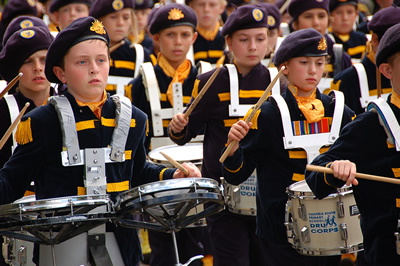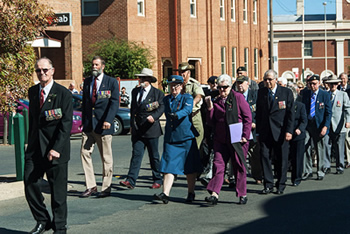Visual arts ES1
Overview

Anzac Day parade, Melbourne, 2013
Students view images in picture books of Anzac Day marches. Students imagine they are marching on Anzac Day and draw the imagined surrounds, an object in those surroundings or a person marching with them. As artists students provide alternate points of view in and through their artworks.
Teaching and learning activities

Vietnam contingent, Anzac Day, Grenfell 2013
How do artists represent significant events?
-
Choose an image from the text ANZAC Biscuits by Phil Cummings and Owen Swan. Talk about what Owen Swan chose to illustrate and how he did so.
-
Discuss the subject matter. What is in the image? Ask students questions about the colours, lines and shapes in the image.
-
Alternately, Owen Swan’s website has three online galleries as well as links to other inspiring illustrators’ works which you may find useful as stimuli.
-
Choose appropriate artworks with simple messages for discussion with young students. You may prefer to print a copy of your chosen image to show your students.
-
Choose an image from the text My Grandad Marches on Anzac Day by Catriona Hoy and Benjamin Johnson and talk about what Benjamin Johnson chose to illustrate and how he did so.
-
Ask students to imagine they are an old person marching on Anzac Day. Consider where they are. Are they in the city or a country town? What do they see while they are marching? What stories would they share with their friends? Have students draw the surroundings they imagine, an object in those surroundings or a person marching with them.
-
Direct students to discuss the lines and shapes in the marching photo. They can use these lines and shapes to draw their own patterns.
Resources:
Stimulus — ANZAC Biscuits by Phil Cummings with illustrations by Owen Swan
‘Owen Swan’s illustrations are breathtaking. His separate use of pencil sketches and watercolours captures the different moods and emotions in the scenes of the alternating stories. His grey and charcoal coloured pencil sketches depict the dark moments on the battle fields, whereas his watercolours in golden shades depict the warmth and love of a family home back in Australia.’
From ANZAC Biscuits by Phil Cummings: A book review and ANZAC activity for children (retrieved 4 November 2015)
My Grandad Marches on Anzac Day by Catriona Hoy and Benjamin Johnson (illustrations)
Drawing – pens, pencils, charcoal, paper
Marching photo as stimulus for discussion and students’ artworks
Learning concepts
These additional questions can be used for discussion or further investigations.
Caring
How do people look after each other during Anzac Day marches?
Community
How do artists represent Anzac Day marches?
If you were marching in an Anzac Day march, what would you see while you are marching?
What stories would you share with your friends?
Commemoration
Why do people march on Anzac Day?
Why do people go to watch Anzac Day marches?
Syllabus links
Students make pictures and other artworks using the media and materials given, representing both real and imagined situations. They appreciate that artists make artworks and they begin to describe some aspects of artworks
VAES1.1 Makes simple pictures and other kinds of artworks about things and experiences.
VAES1.2 Experiments with a range of media in selected forms.
VAES1.3 Recognises some of the qualities of different artworks and begins to realise that artists make artworks.
VAES1.4 Communicates their ideas about pictures and other kinds of artworks.